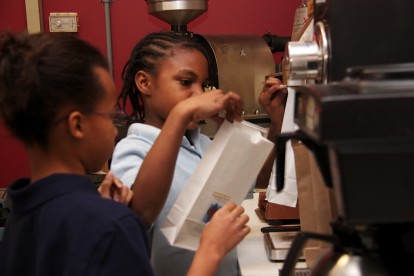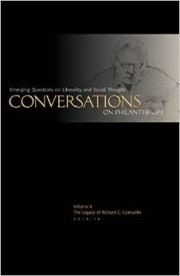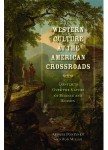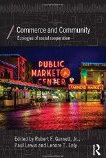Grade School Marketplace
Every Friday, India Ghee receives a paycheck, and like most other Americans, she must decide how much of it she will spend, save, and give. But there are two significant differences between India and the typical American workforce. One, she doesn’t receive her payment in dollars, but in a fictional currency known as “bling.” Two, she’s a 12-year-old student at Harambee Christian School.
Harambee, a private school that serves low-income families in Columbus, Ohio, uses a virtual economy to teach their students about the real world market, and ultimately help youth migrate away from attitudes that lead to intergenerational poverty and toward those that elevate hard work and the subsequent financial benefit.
When Alex Steinman, the principal at Harambee, was in graduate school, he participated in a “mini society” where each of the students were required to put together a business plan to learn how business and society worked. In 1998, when Steinman helped start Harambee—a Kenyan word that translates “all pull together”—he began to wonder how such an experiment might work in an urban context where kids are often disconnected from the realities of the real world marketplace.
Over the next few years as Harambee grew, Steinman began noticing certain prevalent mindsets, most noticeably a spirit of entitlement in many students—and in parents—who often projected the assumption that their needs or desires ought to be met apart from their own efforts. As well, many families elevated immediate gratification over planning toward the future and saving for long-term purchases.
Scott Arnold, director of Central Ohio Youth for Christ—the organization that developed the virtual economy that Harambee would later implement—said in an interview with WORLD Magazine that he knew a family that won $60,000 in the lottery and blew it all so fast that they didn’t have enough money to send their daughter to summer camp.
But financial illiteracy of this sort isn’t exclusive to the poor. It extends far above the poverty line and runs straight across culture as a whole—particularly youth culture.
Results from a 2008 study by the National Jump$tart Coalition indicated a dismal rate of financial literacy among American high school students. The average score on a test that evaluated students’ knowledge of topics such as income, money management, saving, investing, spending, and credit was 48.3 percent, a failing grade. Only a quarter of those surveyed received a C or higher on the test. Those whose parents had higher incomes tended to do slightly—but not substantially—better on the test than those who came from lower income families. Strangely, there was no improvement in scores for those who took a personal finance class in school. However, one noticeable exception jumped out: those who participated in a stock market game—a tool that illustrates how money works in the real world—performed markedly better on the test than those who didn’t.
From Prep School to the Inner City
In 2003, a group of educators from StreetSchool Network—a group of small, private schools for low-income, minority kids who didn’t perform well in traditional schools—came together for a seminar hosted by the Powell Center for Economic Literacy. More than 30 years earlier, Powell had introduced an economics curriculum for K-12 students at the Collegiate School—a prep school in Richmond, Virginia—with huge success.
But could the curriculum be adapted to an urban setting?
At Collegiate, the economic curriculum had been taught using a traditional teaching style that was heavy on didactic instruction and memorization. StreetSchool teachers knew this approach wouldn’t fly with their students, many of whom didn’t care about what they were learning unless they could see how it would impact their life. And so, through the ingenuity of researchers Amy Sherman, director of Sagamore Institute’s Center on Faith in Communities (Charlottesville, VA), and Todd Goble, vice president of StreetSchool, Infusionomics (originally called ele:Vate) was born.
Infusionomics applied a nontraditional approach to economic instruction by taking nine economic principles—including things like choice, cost, resources, and incentives—and “infusing” them into all the aspects of school life, including lessons on history, literature, and science.
From 2006 to 2008, schools in five cities—East Palo Alto, Indianapolis, Memphis, Miami, and Richmond—began implementing the program. Although Harambee was not technically a StreetSchool, it could have been, with 90 percent of its students qualifying for free or reduced lunch. After learning about Infusionomics, Harambee began implementing the program, along with Economis, a web-based token economy developed by Sherman and Central Ohio Youth for Christ.
Bling Makes the World Go Round
At the end of every week, India and her fellow classmates earn “bling” for a variety of different accomplishments they’ve accrued, whether it’s through demonstrating mastery of certain mathematic concepts, doing well on a pop quiz, or helping set up for school. Each of these accomplishments is recorded by the teacher in a web-based program that tallies each student’s points, holds back a small portion for “tax,” and spits out a paycheck—made out in bling—at the end of each week. At this point—the moment when the economic lessons the students have been learning throughout the week come into play—each student has the choice to spend their bling on a toy or candy from the school store or save it up for something bigger, like a trip to an amusement park or a movie.
Steinman explains: “They get that bling in their account and they can just blow it all on little stuff, but they find that they want to go to lunch with their teacher or this outing that happens twice a year. And if they want to go on the outing, not only do they have to earn enough bling, but they have to resist blowing it all.”
That’s how Economis teaches delayed gratification. It also incentivizes good behavior. One teacher estimated that he gained back two and a half hours of instructional time each week when he awarded bling to students who were on time and prepared for class. It also teaches generosity, as students are given the opportunity to contribute a portion of their paycheck to charity. Last year, the students donated around $200 collectively.
But not only do students earn a paycheck, they also contribute to its funding source.
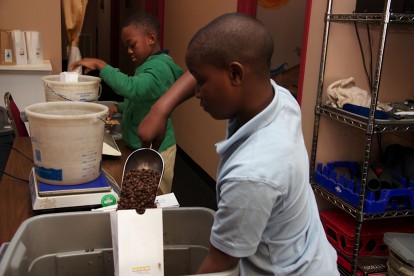 In 2006, under the leadership of local Columbus businessman Bill Sjoblom, Harambee Imports was born. Run by Harambee’s fourth, fifth, and sixth grade classes, Harambee Imports was intended as a way to teach students business skills and support a good cause. Initially, students sold fair trade handicrafts made by women from Hope for Hilltribes, a Christian ministry that reaches out to ethnic minority populations in northern Thailand.
In 2006, under the leadership of local Columbus businessman Bill Sjoblom, Harambee Imports was born. Run by Harambee’s fourth, fifth, and sixth grade classes, Harambee Imports was intended as a way to teach students business skills and support a good cause. Initially, students sold fair trade handicrafts made by women from Hope for Hilltribes, a Christian ministry that reaches out to ethnic minority populations in northern Thailand.
“It’s really a win, win, win, because the students are very much aware of the people in Thailand that they’re supporting, and they’re learning business skills and generating money to support the school economy,” Sjoblom explains.
In 2008, Harambee Imports expanded its business to include its own coffee blend in conjunction with Royal Coffee & Tea Services. At three annual sales events, fourth and fifth graders make the coffee and run the cash registers. Throughout the year, the sixth graders run a Coffee Club, where they fulfill personal mail orders for customers. In addition to giving the students hands-on customer service experience, Sjoblom teaches them about inventory, accounting, and marketing. Over the course of the past seven years, Harambee Imports has generated a gross profit of around $30,000—not an earth shattering number, but one the students can be proud of.
“The way I see it is that this aspect of what we do helps to make school real life—it’s integrating,” Steinman explains. “When the students do the Harambee Imports business, they have to use their math and language and reading that they’re learning in the classroom, so they see it’s important. I think it gives them a taste of what being connected to the mainstream society is like.”
The Payout
Although it’s difficult to draw an exact correlation between Harambee’s approach to economics and student test scores, it’s hard to look past them too. In the last data collection, Harambee elementary students scored in the 60-65th percentile on standardized tests, compared to the 20th percentile claimed by other schools in the district.
The success of their children is causing parents to pay attention. In the fall of 2011, Urban Concern, the parent organization of Harambee, started the Parent University to offer classes to the parents of students, on GED prep, parenting, and financial literacy. Although still in its early stages, the plan is to introduce the virtual economy to parents in a way that would be meaningful to them. For instance, parents who volunteer around the school could earn credits toward a family getaway or gift cards to Walmart or Target.
Today, Infusionomics has impacted more than 35 schools and more than 3,500 students nationwide. And while the program might just brush the surface for some students, India’s mother, Wakeshia Ghee knows that for her daughter, its lessons have gone deep.
“We actually see her using those concepts at home and when we go out. She has a lot more focus on saving and spending money,” Ghee says. “When we go out, I always give my kids a few options, ‘We can do this or we can do this.’ India once said to me, ‘Mom, that’s opportunity cost!’ ”


